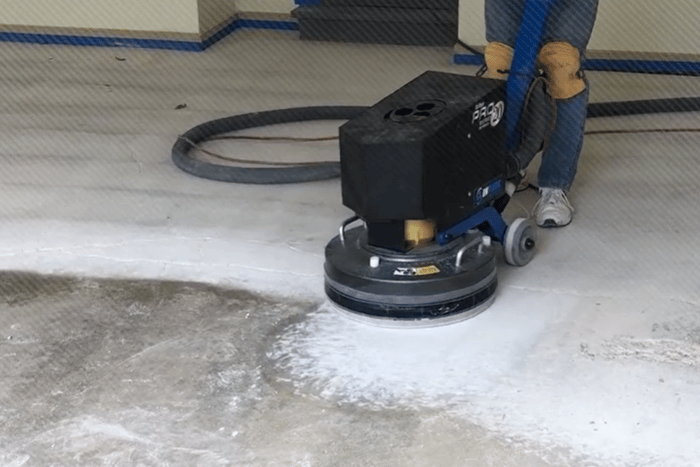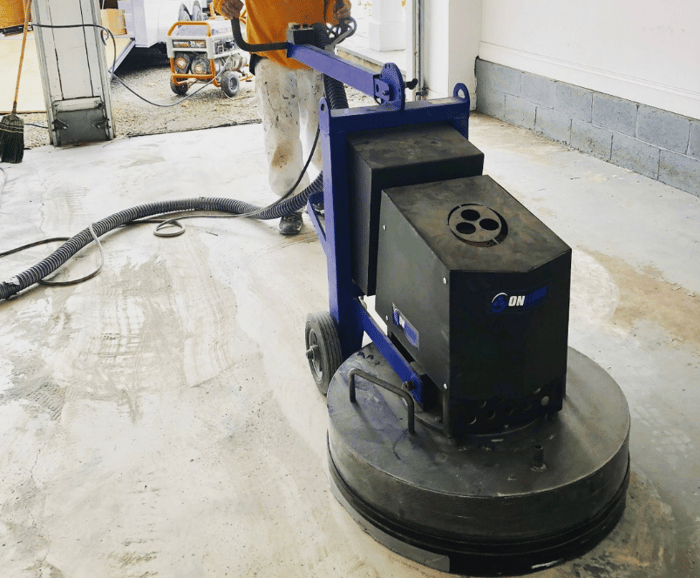Do you need a walk-behind concrete grinder? The answer to that question is probably yes. There are many reasons why you may need one, but the most popular reason is for jobs that require grinding and polishing of concrete slabs.
This article will talk about how to choose the right grinder for your needs and what some of the best models on the market are.
How Does A Walk-Behind Concrete Grinder Work?
A walk-behind concrete grinder has either one or two drums covered with diamond impregnated segments.
As the machine slowly moves, the top edge of the drum rotates and presses against the concrete surface to be polished.
The grinding action removes mill scale, dirt, rust stains, and other imperfections from any concrete floor until it is smooth enough to apply new concrete.
This is how the walk-behind concrete grinder works. The machine slowly crawls across the floor and grinds off any rough spots on your floor, leaving an even surface in its wake, ready for a skim coat of fresh concrete.
Although it operates somewhat like a large rotary floor machine, a walk-behind concrete grinder is significantly smaller.
It also has only two wheels, as opposed to the larger machine's four, making it easier to maneuver around obstacles and harder for pedestrians to trip over.

What Do You Know About The Concrete Grinding Process?
Concrete grinding is the act of using a machine to cut grooves into your concrete surface. A grinder with diamond-impregnated segments slowly crawls across the floor at about 1/16th of an inch per second, removing any imperfections in its wake.
The process begins by getting rid of the top layer of the existing concrete and flooring. This is typically done with a hydraulically-powered saw blade, which can cut through virtually any type of concrete.
After the top layer has been removed, the grinding begins. The grinder covers your existing surface area in an even pattern, removing any rough spots or bumps left behind by the saw blade.
It can take hours, depending on the size of your concrete surface area. It's also best to have multiple workers involved in the process to go more quickly, although machines with two drums are now available.

Why Is There A Need For A Walk-Behind Concrete Grinder?
Does anyone need to grind their concrete? Isn't that what companies are for? Well, yes and no. If you have a lot of concrete, it might not be cost-effective or even possible to have someone do it for you.
For example, if you only do the tiniest amount of grinding with an angle grinder, it will take you a long time and will be frustrating.
If you are planning on grinding a larger area, you might not have the space for a commercial unit or might not even fit through your doors or gates.
In addition, if low-level power lines are running along where you want to work, then again, commercial grinders won't be able to use that area.
So, if you have a lot of concrete to grind, then the only real option is a walk-behind grinder for sale. It'll save you time and effort compared with using an angle grinder, plus you don't need loads of space or any fancy equipment either.
You can also get them reasonably cheap - a top brand can cost up to $20,000, but if you're looking for a cheap walk-behind grinder or one that does, we have you covered.
What Do You Need For Grinding Concrete?
Before we talk about specific grinders, it's essential to know what you'll need to go with them. One of the most critical things with concrete grinding is the dust collection system.
You often have to cut out large sections of concrete so they can be replaced later on, but a dust collection system attached to your grinder help keep everything clean & tidy.
Other than that, you probably want some safety equipment too - safety glasses are a must, and maybe even a helmet like this one or the surface you're grinding might need some special guards to stop it from getting damaged.
Things To Consider For The Right Concrete Floor Grinder?
A floor grinder is an important machine, which you use to restore the look of your worn-out floors by grinding them down until they are smooth and shiny again.
It's usually used in high traffic areas, such as shopping malls, airports, ports, warehouses, etc., but also to restore older floors with a beautiful, polished look.
Floor grinders are great for removing coatings and finishes from concrete floors, including paint or graffiti removal, to reveal a fresh layer of the concrete floor.
Types Of Concrete Grinders
There are three main types of floor grinders, the manual grinder, which is much like a portable drill with a special grinding head on it; there's also the walk-behind machine or electric grinder which you push in front of you.
Both these models are suitable for small to medium-sized projects, but not large ones. The third type is the light commercial floor grinder, which is powerful enough to complete large projects, but still portable and easy to use.
If you're looking for a new floor grinder, there are some important things you should consider before making your purchase:
What Type Of Work Will You Be Using It For?
If you need to make only small, minor repairs, go for the smaller models. However, if you need to do major grinding work or complete larger projects, choose one of the heavier machines.
Size And Weight
Grinders come in different sizes and weights.
Smaller machines are less heavy than larger floor grinders, so they're better for jobs that don't require much power. Choose a machine that's easy to carry and lift, but still powerful enough for the job.
What Type Of Power Supply Do You Need?
Floor grinders can run on electricity or compressed air, so it's important to know what kind of power source is available where you'll be using it.
How Long Will The Machine Last?
When you go shopping for a floor grinder, it's important to check the warranty and service agreements offered by the manufacturer.
This way you'll have peace of mind knowing that your machine is well protected from any manufacturing defects or repair problems.
Are There Other Features You Need?
Depending on what kind of work you do, you may also need a bevel edge guide, work lights, or a vacuum system for collecting dust.
Weigh all your options against what you need to get done and choose accordingly. Check for variable speed control and self-adjusting floating cover with ergonomic work position and one-pass design.

What Sort Of Surfaces Can You Grind?
You can grind many concrete surfaces with a walk-behind concrete grinder, but if you are planning on doing commercial work, there are some limits. The ergonomically designed concrete grinder comes with interesting things.
You might not be able to grind certain types of concrete, such as the old-fashioned "wet set" cement. These surfaces are usually pretty tricky too. You might need a different attachment or maybe even an angle grinder instead for these areas.
Electric Powered Grinders Vs. Gas-Powered Grinders
One of the main advantages of electric-powered walk-behind concrete grinders is that adverse weather conditions do not impact them; if needed, you can still work, even when rain or snow is falling. As a result, you can work continuously during the winter season.
In addition, these grinders are very quiet and do not produce any visible emissions. Electric-powered concrete grinders have a lower carbon footprint than gas-powered ones since they don't rely on gasoline or diesel fuel to operate.
Many users find that gas-powered grinders are easier to maneuver, mainly used on smaller projects.
They are also more lightweight than electric models, making them easier for some workers to handle. In contrast, others prefer an electric grinder's greater power and torque that allows it to break up more rigid materials like cured concrete or asphalt.
Gas-powered walk-behind grinders usually have less vibration than electric models, making them less strenuous on the user.
In addition, they can be used in all weather conditions and do not require a power source other than the gas itself.
Those who work with concrete over a long period report that heavy-duty gas-powered grinders last longer and break down less frequently than electric ones.
On the other hand, gas-powered grinders are heavier, noisier, and emit emissions like carbon monoxide or hydrocarbon gases.
They can also be more challenging to maneuver than electric models, especially on hilly terrain or when used by workers with disabilities.
Gas-powered concrete grinders require regular maintenance to run smoothly; they often break down without them.
Conclusion
Are you tired of having to rent a concrete grinder for your jobs? You don't have to anymore! We offer the best walk-behind concrete grinder that is perfect for any job. It's easy to use and will get the job done quickly, saving you time and money on rentals.
There are many different grinders out there, so it can be challenging to know which one will work best for you.

2 comments